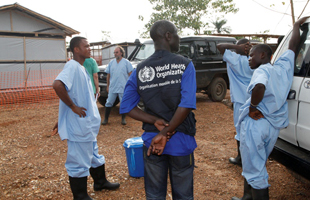You are here
 WHO and medical staff at the Ebola management site in Kailahun District, Sierra Leone
WHO and medical staff at the Ebola management site in Kailahun District, Sierra Leone
WHO/J. Caminade
Kailahun district in eastern Sierra Leone was one of the country’s first hotspots in the Ebola outbreak, at its peak reporting more than 80 new cases per week in late June 2014. With the assistance of WHO and partners, combined with the close involvement of community leaders, the district has managed to beat the disease and has reported no new cases for several weeks. There is no room for complacency however. Community teams and health workers are on high alert and are ready to react quickly to any possible new infection.
who.int - December 2014
Kailahun district borders the area of Guinea where the first cases of Ebola were confirmed at the end of March 2014. The risk of infectious diseases spreading across the border has always been high, as communities are culturally connected and there is a lot of free movement between the two countries. Almost as soon as the outbreak was reported in Guinea, WHO started working closely with the Ministry of Health of Sierra Leone to prepare for possible imported cases of Ebola from Guinea, including organizing training in border areas in April and May.
In spite of these efforts, the disease was carried across the border and, on 25 May, Sierra Leone notified WHO of its first confirmed case. Three days later, Kailahun district already had 7 confirmed cases. The virus then spread so fast that local health capacities in Kailahun were quickly overwhelmed and needed urgent assistance.
WHO immediately established an office in the city. In June, Médecins Sans Frontières (MSF) established an Ebola treatment centre and WHO helped deploy a mobile laboratory from Public Health Canada to test blood and swab samples inside the MSF treatment centre.
“The outbreak in Sierra Leone was still restricted to Kailahun area at the time I arrived in mid-June,” says Dr Zabulon Yoti, WHO team leader who has a long track record of working on many other haemorrhagic fever outbreaks. “There was lots of community resistance. Some areas were not allowing response teams in. My first priority was to help build a broader response structure with full involvement of local leaders and communities.”



Recent Comments